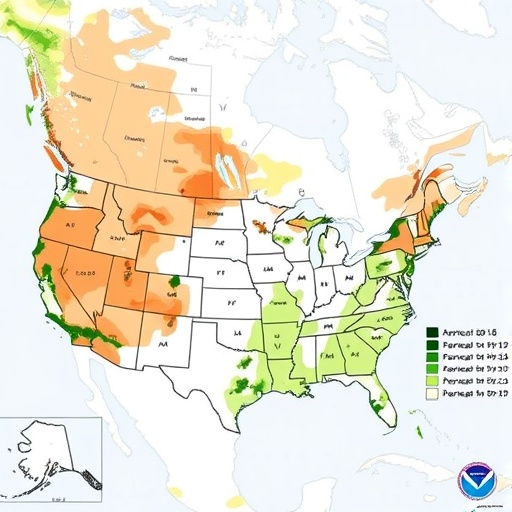In an impressive breakthrough in the field of genomics, researchers have unveiled a novel methodology known as Click-code-seq, which promises to transform our understanding of DNA damage, particularly regarding the processes of oxidation and depurination in the human genome. This research, led by Takhaveev and colleagues, delves into two critical types of DNA damage that can significantly impact cellular function and overall genomic integrity. The manipulation and visualization of these damage types could drastically enhance our knowledge of genetic diseases and the underlying mechanisms of various malignancies.
DNA, the fundamental building block of life, is continually subjected to its environment and internal processes, leading to various forms of damage. Among the most prominent types of damage are oxidation and depurination. Oxidative stress, usually stemming from metabolic processes or environmental factors, can result in modified bases within the DNA structure. Conversely, depurination results in the loss of purine bases, adenine and guanine, which can lead to mutations if not repaired effectively. Understanding how these processes correlate with specific strands of DNA is crucial for elucidating the pathways to various diseases.
The Click-code-seq technique introduced in this study represents a cutting-edge approach to mapping DNA damage with unprecedented precision. By integrating click chemistry into the sequencing workflow, researchers can tag and quantify sites of oxidation and depurination across the genome. This technique allows for a more detailed interpretation of strand bias, emphasizing that the frequency and types of damage can differ significantly between the two complementary strands of DNA. Such insights could have profound implications for understanding mutagenesis and disease development.
Significantly, the researchers revealed that the patterns of DNA damage observed in various samples are not uniform. The Click-code-seq methodology has illuminated particular biases in susceptibility to oxidative damage and depurination with respect to specific genomic regions. Such findings suggest that intrinsic properties of DNA sequences play a pivotal role in determining vulnerability to damage, which could pave the way for new therapies targeting susceptible genomic loci in conditions where oxidative damage is prevalent.
The visualization capabilities of Click-code-seq are another standout feature of this research. Instead of merely detecting the presence of oxidative and depurination damage, researchers can now visualize and track these lesions throughout the genome. This spatial understanding enables the determination of potential hotspots for damage accumulation, thereby providing valuable insights into the mechanisms by which cells maintain genomic stability over time.
Additionally, the implications of this research stretch beyond merely understanding DNA integrity. The complex interplay between environmental factors, genetic predispositions, and cellular responses to DNA damage could yield new insights into how diseases—especially cancers—develop and progress. The data generated by Click-code-seq establishes a foundational tool for exploring the dynamic relationships between oxidative stress and genomic stability, with applications in personalized medicine and therapeutic intervention tactics.
Moreover, the adoption of Click-code-seq across various models can lead to multi-faceted applications. It is pertinent to consider how this approach can shed light on developmental biology, aging, and even evolutionary biology, where DNA damage accumulates over generations. The potential for Click-code-seq to elucidate markers of aging—effectively demonstrating how organisms adapt or succumb to long-term exposure to oxidative stress—further enhances its relevance across diverse biological fields.
From a technical perspective, the integration of Click-code-seq into existing genomic research workflows is noteworthy. The method’s reliance on click chemistry, known for its efficiency and specificity, presents an elegant solution to the complexities of DNA damage detection and analysis. Its adaptability for high-throughput sequencing affords researchers the opportunity to apply this cutting-edge methodology across various sample types, enhancing its applicability and reach.
As the ramifications of this groundbreaking research unfold, further studies will undoubtedly explore the full spectrum of DNA lesions and their consequences on human health. The impressive capabilities of Click-code-seq are not merely limited to oxidative stress and depurination; researchers can adapt the technology to uncover the nuances of other forms of DNA damage, broadening the horizons of genomic research.
The implications of Takhaveev and colleagues’ work extend beyond the descriptions of molecular mechanisms. The mere fact that certain sections of the human genome are intrinsically more prone to damage prompts a reevaluation of current models of genomic stability and disease susceptibility. This research contributes a critical piece to the puzzle of how genetic variations influence individual health outcomes amidst a backdrop of continuous DNA damage.
In conclusion, the advent of Click-code-seq as an analytical tool opens the door to a myriad of research opportunities, promising to reveal previously obscured details regarding DNA damage and repair processes. The insights gained from exploring strand biases of DNA oxidation and depurination will certainly set the stage for future efforts to intervene at the genomic level, potentially transforming how we approach the prevention and treatment of genetic disorders and cancer.
As the scientific community continues to absorb and integrate these findings, the energy around the Click-code-seq methodology and its implications is likely to snowball. With its potential applications for many biological disciplines, this innovative approach is indeed set to make waves well beyond its current use, offering tantalizing prospects for the future of genome research.
The journey of understanding and mitigating DNA damage is far from over, but with strides like those made by Takhaveev’s team, our trajectory is bright, promising, and thriving with the potential for groundbreaking discoveries.
Subject of Research: DNA damage mechanisms, including oxidation and depurination within the human genome.
Article Title: Click-code-seq reveals strand biases of DNA oxidation and depurination in human genome.
Article References: Takhaveev, V., Püllen, N.J.L., Singh, N.K. et al. Click-code-seq reveals strand biases of DNA oxidation and depurination in human genome.
Nat Chem Biol (2025). https://doi.org/10.1038/s41589-025-02052-6
Image Credits: AI Generated
DOI: https://doi.org/10.1038/s41589-025-02052-6
Keywords: DNA oxidative stress, depurination, Click-code-seq, genomic stability, DNA damage, cancer research.
Tags: advanced techniques in genomicsClick-code-seq methodologyDNA damage visualization techniquesgenomic integrity and cellular functionimpact of environmental factors on DNAmapping DNA strand biasesnovel genomics research breakthroughsoxidation and depurination in DNAoxidative stress and genetic diseasespurine base loss and mutationstransformative DNA research methodologiesunderstanding DNA damage mechanisms





